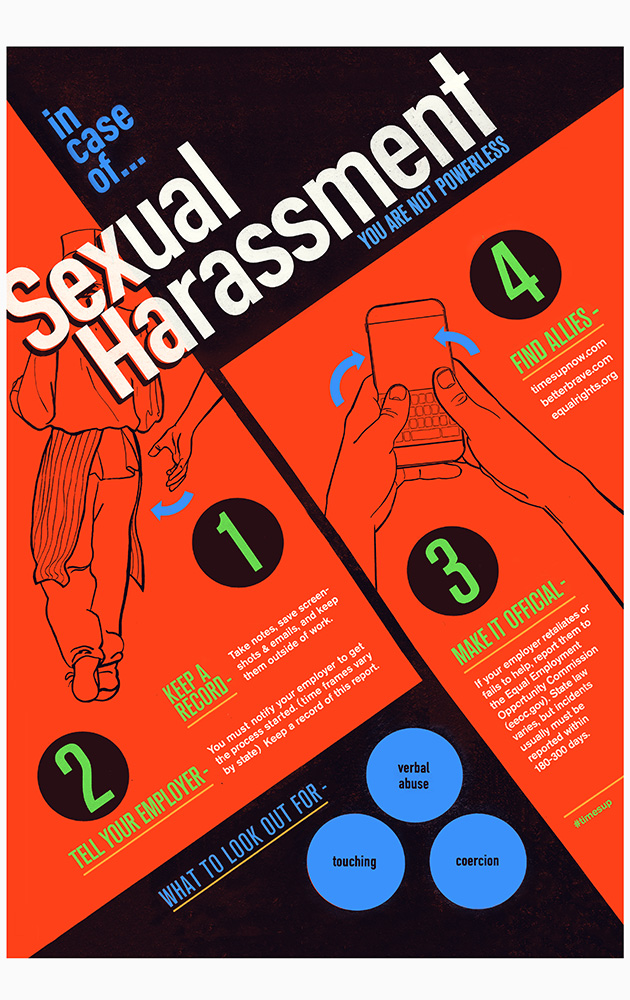
shironosov/Getty
The #MeToo movement has helped unearth instances of sexual harassment and impropriety at dozens of restaurants across the country, from New York to New Orleans. “This was a reckoning—things will never be the same again,” the New York Times‘ food writer Kim Severson said on our latest episode of Bite.
But beyond greater publicity about the fact that the majority of restaurant staffers have experienced harassment—what’s it going to take to change the culture? Here are a few practical ideas on where restaurants can start:
Clear and catchy reminders: When news of sexual harassment scandals broke, Karen Leibowitz, co-founder of San Francisco’s The Perennial and Mission Chinese Food restaurants, wanted to empower her staff to protect themselves. Taking inspiration from fliers in restaurants with instructions on how to save someone who is choking, Leibowitz worked with designer Kelli Anderson and Cherry Bombe magazine to create a poster showing how to respond to and report sexual harassment in the kitchen. “So many of the stories we hear in the restaurant industry are of people feeling powerless,” Leibowitz told Bite. The poster is “a message to anyone who sees the poster that they have allies and some pointers for how to reach them.”—Kiera Butler
Here’s the poster—and you can download it here.
Burly men: What if the sexual harasser is a customer? Leibowitz says that’s pretty common in restaurants, and her team has developed a system to deal with it. “If a customer is inappropriate with a server, then that server just taps out and a different server takes over that table,” she says. “Usually our biggest, scariest looking guy.”—Kiera Butler
Color codes: The staff at a mac ‘n’ cheese restaurant in Oakland called Homeroom devised an even more structured way of swapping out servers who feel bothered by unwanted attention or creepy stares from their diners. If a server feels uncomfortable, she just has to say “yellow,” “orange,” or “red” to her manager, as the San Francisco Chronicle‘s Tara Duggan explains. “Yellow” means the manager keeps an eye out on the table, while “orange” means the manager takes over the table. And “red” will get the customer kicked out completely. “I think it acknowledges that harassment can be very subtle,” Duggan notes. You can read her full story on Homeroom’s tactics here.—Maddie Oatman
Guaranteed living wages: Servers in 43 states get paid as little as $2.13 an hour on what’s called a “tipped minimum wage.” They’re supposed to make up the rest of their wages on customer tips, which means “they have to tolerate whatever a customer does to them, because their customer is paying their bills, not the employer,” explains Saru Jayaraman, head of the Restaurant Opportunities Centers United and our guest on two previous episodes of Bite. On the other hand, in the seven states that mandate a full minimum wage rather than the tipped minimum wage for restaurant workers, ROC’s research has shown that “the workers don’t have to put up with anything and everything to get some take-home pay. When a customer comes in and tries to grab them, they don’t have to tolerate it because they know they have another source of income.”—Maddie Oatman
Smart funding: One reason sexual harassers can flourish in restaurants is simple math: Just 33 percent of restaurant businesses are majority-owned by women, and women make up just 19 percent of chefs and 7 percent of head chefs. And one reason for that is financing. “Getting loans and getting people to invest in your company can be harder if you’re a woman—particularly if the people lending the money unconsciously or consciously have specific biases against a female-run business,” Severson says.
But as more women gain wealth in fields like tech and venture capital, “you’ll start to see a shift,” she says—more women in the investor class will translate to easier financing for women who want to launch their own restaurants. Severson also thinks that in the wake of #MeToo, “women feel more empowered to take a risk and want to start their own business now, because I think there’s a real hunger out there for supporting and eating out at restaurants that are run by women.”—Tom Philpott














